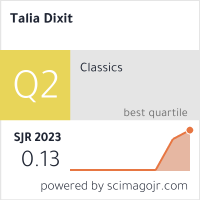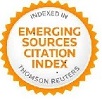Retórica del parentesco en la biografía temprana de Ciro (Hdt. 1.107-130)
DOI:
https://doi.org/10.17398/Palabras clave:
Heródoto, Ciro, biografía, identidad, parentesco, retóricaResumen
Este artículo se centra en la retórica del parentesco en la biografía temprana del fundador del Imperio persa incluida en las Historias de Heródoto, o sea, dentro del relato herodoteo sobre el nacimiento, la infancia y la llegada al poder de Ciro II de Persia. Su objetivo es mostrar la influencia que las relaciones de parentesco entre los personajes del relato tienen sobre la construcción de la identidad de Ciro. Para ello, el artículo examina los actos discursivos mediante los cuales los personajes se refieren a los vínculos familiares que hay entre ellos, así como las matizaciones e interpretaciones realizadas al respecto por el narrador. Los resultados del análisis indican que no existe una sola identidad de Ciro, sino tres (príncipe, esclavo y conquistador), que se combinan configurando un ejemplo paradigmático del arquetipo del héroe que nace para gobernar, pero arrostra grandes dificultades causadas por parientes o personas de su entorno.
Descargas
Referencias
ASHERI, D. (1988), Erodoto. Le Storie. Vol. 1, Libro I, La Lidia e la Persia, Milán: Fondazione Lorenzo Valla, Mondadori.
AVERY, H. C. (1972), “Herodotus’ Picture of Cyrus”, The American Journal of Philology 93: 529-546.
DE BAKKER, M. (2007), Speech and Authority in Herodotus’ Histories, Ámsterdam (Tesis Doctoral).
BARAGWANATH, E. (2015), “Characterization in Herodotus”, en R. Ash, J. Mossman y F. B. Titchener (eds.), Fame and Infamy. Essays for Christopher Pelling on Characterization in Greek and Roman Biography and Historiography. Oxford: Oxford University Press, pp. 17-36.
BECKMAN, D. (2018), “The Many Deaths of Cyrus the Great”, Iranian Studies 51: 1-21.
BICHLER, R. (1985), “Die ‘Reichsträume’ Herodots. Eine Studie zu Herodots schöpferischer Leistung und ihrer quellenkritischen Konsequenz”, Chiron 15: 125-147.
BINDER, G. (1964), Die Aussetzung des Königskindes Kyros und Romulus, Meisenheim am Glan: Anton Hain Verlag.
BOEDEKER, D. (2011), “Persian Gender Relations as Historical Motives in Herodotus”, en R. Rollinger, B. Truschnegg y R. Bichler (eds.), Herodot und das Persische Weltreich. Akten des 3. Internationalen Kolloquiums zum Thema «Vorderasien in Spannungsfeld klassischer und altorientalischer Überlieferungen», Innsbruck, 24.-28. November 2008, Wiesbaden: Harrassowitz Verlag, pp. 211-235.
CAMPOS MÉNDEZ, I. (2002), El culto al dios Mithra en la Persia Antigua, Las Palmas de Gran Canaria: Princeps Colección.
CORCELLA, A. (1984), Erodoto e l’analogia, Palermo: Sellerio editore.
DEWALD, C. (1981), “Women and Culture in Herodotus’ Histories”, en H. Foley (ed.), Reflections of Women in Antiquity, Nueva York: Gordon and Breach Science Publishers, pp. 91-125.
DORATI, M. (2013), “Der Zugang zu den Gedanken von Personen in Herodots Historien”, en K. Geus, E. Irwin y T. Poiss, (eds.), Herodots Wege des Erzählens. Topos und Logos in den Historien, Fráncfort del Meno: Peter Lang Verlag, pp. 153-185.
FITZSIMONS, S. (2017), The Leadership Styles of the Persian Kings in Herodotus’
Histories, Manchester (Tesis Doctoral).
FRISCH, P. (1968), Die Träume bei Herodot, Meisenheim am Glan: Verlag Anton Hain.
GAZZANO, F. (2017), “The King’s Speech. La retorica dei rei persiani fra Eschilo, Erodoto e Tucidide”, Electrum 24: 55-73.
GRAF, D. F. (1984), “Medism: The Origin and Significance of the Term”, Journal of Hellenic Studies 104: 15-30.
GRAY, V. J. (1995), “Herodotus and the Rhetoric of Otherness”, The American Journal of Philology 116: 185-211.
– (2015), “Herodotus (and Ctesias) Re-enacted: Leadership in Xenophon’s Cyropaedia”, en J. Priestley y V. Zali (eds.), Brill’s Companion to the Reception of Herodotus in Antiquity and Beyond, Leiden: Brill, 301-321.
GREENBERGER, J. S. (1987), Fathers and Sons in the Histories of Herodotus, Columbus (Tesis Doctoral).
GRETHLEIN, J. (2013), Experience and Teleology in Ancient Historiography. ‘Futures Past’ from Herodotus to Augustine, Cambridge: Cambridge University Press.
HARRIS, W. V. (2009), Dreams and Experience in Classical Antiquity, Cambridge (Ma.): Harvard University Press.
HARRISON, T. (2000), Divinity and History. The Religion of Herodotus, Oxford: Oxford University Press.
HAUSSKER, F. (2017), “The Ekthesis of Cyrus the Great. A Case Study of Heroicity versus Bastardy in Classical Athens”, The Cambridge Classical Journal 63: 1-15, doi:10.1017/S1750270517000021.
HAZEWINDUS, M. W. (2004), When Women Interfere. Studies in the Role of Women in Herodotus’ Histories, Ámsterdam: J. C. Gieben.
IGLESIAS ZOIDO, J. C. (2008), “La arenga militar en la historiografía griega: el modelo de Tucídides y sus antecedentes literarios y retóricos” en J. C. Iglesias Zoido (ed.), Retórica e historiografía. El discurso militar en la historiografía desde la Antigüedad hasta el Renacimiento, Madrid: Ediciones Clásicas, pp. 231-258.
IMMERWAHR, H. R. (1966), Form and Thought in Herodotus, Cleveland: Press of Western Reserve University.
LATEINER, D. (1987), “Nonverbal Communication in the Histories of Herodotus”, Arethusa 20: 83-119.
MÜLLER, S. (2009), “The disadvantages and advantages of being fatherless: The case of Sulla”, S. R. Hübner y D. M. Ratzan (eds.), Growing up fatherless in Antiquity, Cambridge: Cambridge University Press, pp. 195-216.
MUNSON, R. V. (2009), “Who Are Herodotus' Persians?”, The Classical World 102: 457-470.
OPPENHEIM, A. L. (1956), “The Interpretation of Dreams in the Ancient Near East: With a Translation of an Assyrian Dream-Book”, Transactions of the American Philosophical Society 46: 179-373.
PEDRUCCI, G. (2016), “Breastfeeding Animals and Other Wild «Nurses» in Greek and Roman Mythology”, Gerión 34: 307-323.
PELLING, C. (1996), “The Urine and the Vine: Astyages’ Dreams at Herodotus 1.107-8”, Classical Quarterly 46: 68-77.
– (2006), “Educating Croesus: talking and learning in Herodotus’ Lydian
Logos”, Classical Antiquity 25: 141–177.
– (2016), “Herodotus’ Persian Stories: Narrative Shape and Historical Interpretation”, Syllecta Classica 27: 65-92.
POWELL, J. E. (1938), A Lexicon to Herodotus, Cambridge: Cambridge University Press.
REINHARDT, K. (1940), “Herodots Persergeschichten”, en W. F. Otto, K. Reinhardt y E. Grassi (eds.), Geistige Überlieferung. Ein Jahrbuch, Berlín: Küpper, pp. 138-184.
SCHRADER, C. (1977), Historia. Libros I-II. Heródoto; traducción y notas de Carlos Schrader, Madrid: Gredos.
SOARES, C. (2001), “Tolerância e xenofobia ou a consciência de um universo multicultural nas Histórias de Heródoto”, Humanitas 53: 49-82.
STRONG, A. K. (2010), “Mules in Herodotus: the Destiny of Half-Breeds”, Classical World 103: 455-464.
WATERS, M. (2004), “Cyrus and the Achaemenids”, Iran: Journal of Persian Studies 42: 91-102.
WESSELMANN, K. (2011), Mythische Erzählstrukturen in Herodotus Historien, Berlín: de Gruyter.
WOLTERS, A. (2000), “A Semantic Study of αὐθέντης and its Derivatives”, Journal of Greco-Roman Christianity and Judaism 1: 145-175.
– (2009), “αὐθέντης and its Cognates in Biblical Greek”, The Journal of the Evangelical Theological Society 52: 719-729.
ZOURNATZI, A. (2013), “The Median Logos of Herodotus and the Persians’ Legitimate Rule of Asia”, Iranica Antiqua 48: 221-252.
Publicado
Versiones
- 2024-11-04 (2)
- 2018-10-01 (1)













